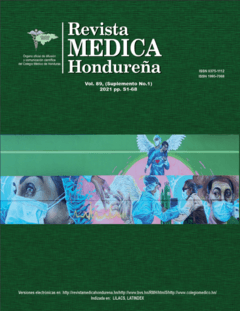Fetus In Fetu: caso clínico estudiado con tomografía tridimensional
DOI:
https://doi.org/10.5377/rmh.v89iSupl.1.12183Palabras clave:
Anomalías Congénitas, Fetus in fetu, Gemelos Siameses, Gemelos MonocigóticosResumen
Antecedentes: Fetus in fetu (FIF) es una rara anomalía congénita de gemelos monocigotos asimétricos, donde el gemelo parásito se desarrolla anormalmente dentro del cuerpo del gemelo huésped. Actualmente hay menos de 200 casos reportados a nivel mundial siendo este el segundo caso en Honduras. Caso clínico: Se reporta el caso de un paciente masculino, recién nacido a término en la sala de maternidad del Hospital San Felipe, quien a su nacimiento se observó distensión abdominal, hernia umbilical, hernia inguino-escrotal izquierda y tumoración en el hipocondrio izquierdo por lo que se decide realizar una radiografía anteroposterior toracoabdominal revelado un tumor en la región izquierda del abdomen con presencia de calcificaciones. Se refiriere al Hospital Escuela Universitario donde se le efectuó un ultrasonido abdominal total con reporte de masa heterogénea de 5 cm3 de volumen con componente cálcico en su interior, que tuvo que ser correlacionada con tomografía axial computarizada con reconstrucción 3D dando como resultado masa heterogenia con huesos axiales y apendiculares en su interior compatible con FIF. Se realizó intervención quirúrgica con resección de tumoración retroperitoneal y sus anexos sin secuelas ni complicaciones por lo cual se da alta médica. Conclusión: Aunque el FIF es una enfermedad muy rara, el tratamiento de elección será la resección de la masa y su pronóstico es favorable cuando la masa se ubica en el área retroperitoneal. Se puede observar que la tomografía tridimensional es una técnica de imagen útil para la diferenciación entre un FIF y un teratoma en el diagnóstico preoperatorio.
Descargas
473




